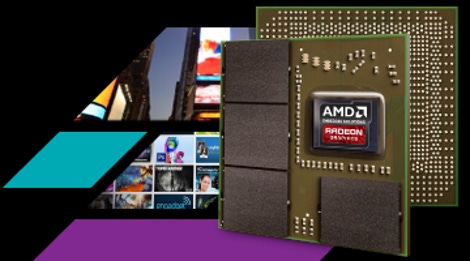AMD Launches 2nd-Gen Embedded R-Series APUs and CPUs
Steamroller-based processors first embedded solutions to incorporate AMD's Heterogeneous System Architecture
May 22, 2014

AMD announced the second generation of embedded R-series accelerated processing unit (APU) and CPU family (previously codenamed “Bald Eagle”) for embedded applications. Built on AMD's Steamroller CPU architecture and Graphics Core Next (GCN) architecture, the new R-series APU and CPU are designed for mid- to high-end visual and parallel compute-intensive embedded applications with support for Linux, RTOS (Real Time Operating Systems) and Windows operating systems.
With graphics performance and performance-per-watt as the focus, the new R-series APU is the first embedded processor to incorporate HSA (Heterogeneous System Architecture) in its design, enabling applications to distribute workloads to run on the best compute element; either CPU, GPU, or a specialized accelerator such as video decode.
At its 2013 Developer Summit AMD discussed APU product roadmaps and the HSA architecture with a spotlight on partner collaboration and empowering developers. The same focus applies for the embedded market, as the AMD R-series will vie for market share against Intel Haswell chips, with the help of AMD's latest Grahics Core Next (GCN) architecture.
Through an agreement with Mentor Graphics, and with AMD being a gold-level member of the Yocto Linux collaboration project, embedded systems developers now have access to customized embedded Linux development and commercial support on the second generation AMD Embedded R-series family. The new APUs feature dual-channel memory with error-correcting code (ECC), DDR3-2133 support and configurable TDP (thermal design power) for system design flexibility to optimize the processor at a lower TDP. AMD has pledged a 10-year support lifetime for the R-Series chips.
“When it comes to compute performance, graphics performance and performance-per-watt, the second-generation AMD Embedded R-series family is unique in the embedded market,” said Scott Aylor, corporate vice president and general manager of AMD's Embedded Solutions division. “The addition of HSA, GCN and power management features enables our customers to create a new world of intelligent, interactive and immersive embedded devices.”
The embedded market that AMD is targeting has a diverse set of needs. For embedded visual applications like gaming machines and digital signage the new R-series APUs can provide flexibility and scalability, with support for up to nine independent displays and 4K resolution with the combination of the new AMD Radeon E8860 embedded discrete GPU. For medical imaging the new APUs deliver high image transformation performance and low latencies in a low-power and highly integrated solution for medical imaging device vendors.
The advanced parallel-compute graphics engine in the new APUs give networking companies a high-performance GPU, enabling acceleration of parallelizable functions, such as deep packet inspection, encryption or decryption, search and compression or decompression, allowing more CPU headroom for customers to help increase feature velocity.
About the Author
You May Also Like







